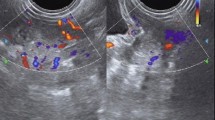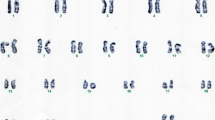Abstract
A patient is described with some features of the Turner syndrome (dwarfism, pterygium colli, hypoplasia mandibulae and syndactylism) but with normal genital development.*
In the skin 9.6% of the nuclei were Barr-positive. Skin and blood-cultures revealed that she was a mosaic with an XO and an X-ring cell-line. The ring-chromosome is assumed to be derived from an X-chromosome.
A possible explanation for the existence of patients with some features of the Turner syndrome and normal genital development is discussed.
Similar content being viewed by others
References
Bahner, F., G. Schwarz, H. A. Hienz &K. Walter (1960). Turner-Syndrom mit voll ausgebildeten secundären Geschlechtsmerkmalen und Fertilität.Acta Endocrin. 35: 397–404.
Baikie, A. C., W. M. Court Brown, P. A. Jacobs &J. S. Milne (1959). Chromosome studies in human leukaemia.The Lancet II: 425–428.
Bain, A. D. &I. K. Gauld (1963). Multiple congenital abnormalities associated with ring chromosome.The Lancet II: 304–305.
Bender, M. A. &P. C. Gooch (1961). Somatic chromosome aberrations in normal and irradiated humans.Radiation Research 14: 451.
Darlington, C. D. (1937). Recent advances in cytology. Blakiston, Philadelphia.
Genest, P., R. Leclerc &C. Auger (1963). Ring chromosome and partial translocation in the same cell.The Lancet II: 1426–1427.
Harnden, D. G. (1960). A human skin culture technique used for cytological examinations.Brit. J. Expt. Path. 41: 31–37.
Hustinx, T. W. J. (1963). Een ring-X-chromosoom in een deel der somatische cellen van een patient met kenmerken van het syndroom van Turner.Genen en Phaenen 8: 49–53.
Hustinx, T. W. J. (1963). An X-ring chromosome in a Turner patient without a specific peripheral localisation. Genetics Today, Proceedings of the XI International Congress of Genetics I: 313.
Ishihara, T., G. E. Moore &A. A. Sandberg (1962). Thein vitro chromosome constitution of cells from human tumors.Cancer Research 22: 375–379.
Ising, U. &A. Levan (1957). The chromosomes of two highly malignant human tumours.Acta Path. Microbiol. Scand. 40: 13.
Jacobs, P. A., D. G. Harnden, W. M. Court Brown, J. Goldstein, H. G. Close, T. N. Mac Gregor, N. Mac Lean &J. E. Strong (1960). Abnormalities involving the X-chromosome in woman.The Lancet I: 1213–1216.
Kemp, N. H., M. K. Lucas &J. R. Ellis (1963). An autosomal ring chromosome in a human female with congenital malformations.Heredity 18: 123.
Lejeune, J., R. Turpin &M. Gauthier (1960). Etudes des chromosomes somatiques humains. Technique de culture des fibroblastes in vitro.Revue Franc. d'ét. Clin. et Biol. 5: 406–408.
Levan, A. (1956). Self-perpetuating ring chromosome in two human tumours.Hereditas 42: 366–372.
Lindsten, J. &K. G. Tillinger (1962). Self-perpetuating ring chromosome in a patient with gonadal dysgenesis.The Lancet I: 593–594.
Lucas, M., N. H. Kemp, J. R. Ellis &R. Marshall (1963). A small autosomal ring chromosome in a female infant with congenital malformations.Ann. Hum. Genet. 27: 189–195.
Lüers, Th., E. Struck &J. Nevinny-Stickel (1963). Self-perpetuating ring chromosome in gonadal dysgenesis.The Lancet II: 887.
Moorhead, P. S., P. C. Nowell, W. J. Mellman, D. M. Battips &D. A. Hungerford (1960). Chromosome preparations of leukocytes cultured from human peripheral blood.Expt. Cell Research 20: 613–616.
Muldal, S., C. W. Gilbert, L. G. Lajtha, J. Lindsten, J. Rowley &M. Fraccaro (1963). Tritiated thymidine incorporation in an isochromosome for the long arm of the X chromosome in man.The Lancet I: 861–863.
Ohno, S. (1962). More about the mammalian X chromosome.The Lancet II: 152.
Puck, T. T. (1958). Action of radiation on mammalian cells. 3. Relationship between reproductive death and induction of chromosome anomalies by X-irradiation of euploid human cells in vitro.Proc. Nat. Acad. Sci. 44: 772–780.
Rothfels, K. H. &L. Siminowitch (1958). An air-drying technique for flattening chromosomes in mammalian cells grown in vitro.Stain Techn. 33: 73–77.
Sandberg, A. A., T. Ishihara, L. H. Crosswhite &T. S. Hauschka (1962). Chromosomal dichotomy in blood and marrow of acute leukaemia.Cancer Research 22: 748–756.
Scherz, R. G. (1962). Blaze drying, by igniting the fixative, for improved spreads of chromosomes in leukocytes.Stain Techn. 37: 386.
Smith-White, S., W. J. Peacock, B. Turner &G. M. Den Dulk (1963). A ring chromosome in man.Nature 197: 102–103.
Swanson, C. P. (1957). Cytology and cytogenetics. Prentice Hall, Inc., Englewood Cliffs, N.J.
Tough, I., K. E. Buckton, A. G. Baikie &W. M. Court Brown (1960). X-ray induced chromosome damage in man.The Lancet II: 849–851.
Turner, B., A. N. Jennings, G. M. Den Dulk &T. Stapleton (1962). A self-perpetuating ring chromosome.Med. J. Austr. 2: 56–58.
Wang, H. C., J. Melnyk, L. T. McDonald, I. A. Uchida, D. H. Carr &B. Goldberg (1962). Ring chromosomes in human beings.Nature 195: 733–734.
Author information
Authors and Affiliations
Rights and permissions
About this article
Cite this article
Hustinx, T.W.J., Stoelinga, G.B.A. A ring-X-chromosome in part of the somatic cells of a patient with some characteristics of the Turner syndrome. Genetica 35, 1–14 (1964). https://doi.org/10.1007/BF01804870
Received:
Issue Date:
DOI: https://doi.org/10.1007/BF01804870




